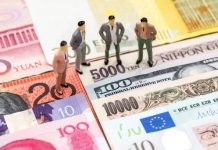Traditionally, September has been the worst month of the year for the US stock market, but the current rally doesn’t seem to fade as of today. The S&P 500 (+0.75%) and Nasdaq (+1.39%) improved their record highs on Tuesday, driven by tech stocks.
Apple rose about 4% after its stock split took effect on Monday. Also, the company reportedly had required suppliers to produce no less than 75 million 5G iPhones by the end of 2020.
Elsewhere, videoconferencing app provider Zoom jumped over 40% as it raised its annual revenue outlook by over 30% due to the rapid increase in its paid subscriptions. Zoom and Amazon led the Nasdaq rally.
Dow Jones advanced 0.76% during the second day after the implementation of slight modifications in which three companies were replaced, and Apple lost some weight in the index.
Tech companies have led the bullish trend given the digitalization of activities amid the pandemic. Besides their contribution, the US stock market converted stimulus talks and upbeat economic data.
The US Congress continues the negotiations over the fresh stimulus measures. Elsewhere, Fed Governor Lael Brainard said on Tuesday that the central bank would need to introduce new efforts to support the economy in the coming months, hinting to more stimulus measures. The comments came after Fed Chief Jerome Powell sent a dovish signal last week.
Investor sentiment is also boosted by the optimism around the economic recovery as the number of new COVID-19 infections is declining in the US. The ISM Manufacturing Index rose to 56.0 last month from 54.2 in July, beating analysts’ forecasts of a moderate growth to 54.5. New orders rose to their highest level in more than 16 years.
Asian stocks have also leveraged the US manufacturing activity data and the tech rally. China also reported upbeat factory data on Tuesday – Caixin manufacturing PMI rose to 53.1 last month, which was the best performance since January 2011. Still, Chinese equities are now correcting. At the time of writing, China’s Shanghai Composite is down 0.42%, and the Shenzhen Component has lost 0.03%, though it has recovered some earlier losses. Hong Kong’s Hang Seng Index is down 0.20%.
Japan’s Nikkei 225 is up 0.41%, as Yoshihide Suga is expected to announce his candidacy to lead the ruling Liberal Democratic Party (LDP) later today. Suga has the most chances to replace incumbent Prime Minister Shinzo Abe, who resigned due to health problems.
South Korea’s KOSPI has inched up 0.18%. The country’s inflation rose 0.7% in August.
In Australia, the ASX 200 has jumped 1.81%. While the Australian Bureau of Statistics confirmed the first recession in three decades, investors focused on the declining number of coronavirus cases and the prospects of lockdown easing in the state of Victoria.
European stocks will follow the US bullishness, judging by the index futures. Currently, DAX futures are up 0.45%, and FTSE has added 0.78%.
In the commodity market, gold is retreating as the US dollar is leveraging the US manufacturing data. On Monday, gold rose to the highest since mid-August as the greenback dropped to the lowest in years. Nevertheless, fresh hopes for economic recovery are supporting the American currency at the expense of the metal, which is down 0.50% to $1,970 per ounce.
Oil futures continued to improve on Wednesday after a bigger-than-expected decline in US crude stockpiles. The upbeat manufacturing data from the US and China have also contributed to the risk appetite. Brent and WTI brands are both up 0.94% as of now.
The American Petroleum Institute said that US crude inventories had declined by 6.4 million barrels in the week ending August 28, while analysts expected a drop by 1.9 million barrels.
In FX, the US dollar has bounced back from two-year lows, supported by the same US manufacturing data. EUR/USD is down 0.04%. On Monday, the pair broke above 1.20 for the first time since May 2018.
GBP/USD is moving sideways, while the Japanese Yen has lost 0.07% versus the USD.
The Australian dollar has lost 0.17% versus the American counterpart as the country officially entered a recession. Australia’s GDP contracted in the second quarter by 7%, which is the worst slump on record.












